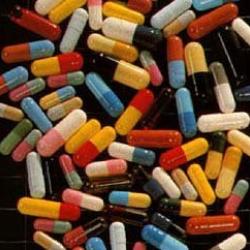Source Institutions
Source Institutions
Add to list Go to activity
Activity link broken? See if it's at the internet archive

In this activity, learners discover how gelatin can be used as a medium for drug delivery. Learners create colored gelatin and then cut out pieces of the gelatin to simulate medicine (pills). Learners then put their simulated pills in a pan of hot water. Since gelatin is a thermoreversible or cold-setting polymer, gelatin will convert back to a liquid if put in a hot environment. As the gelatin returns to its liquid form, it releases its embedded dye. The dye eventually diffuses completely out of the gelatin which simulates the slow release of a drug from a pill. From this activity, learners learn more about diffusion and drug delivery. Adult supervision recommended.
- Under 5 minutes
- 4 to 24 hours
- $1 - $5 per group of students
- Ages 8 - 18
- Activity
- English
Quick Guide
Materials List (per group of students)
- Knox Gelatin, 21-grams
- Razor blade or other cutting implement
- Food coloring (blue works best)
- Distilled Water
- Baking pan or similar container
- Hot plate or microwave
Subjects
-
Engineering and Technology
-
Engineering
- Bioengineering/Biomedical Engineering
- Metallurgy and Materials Engineering
-
Engineering
-
Physical Sciences
-
Heat and Thermodynamics
- Heat and Temperature
-
Chemistry
- Chemical Bonding
- Chemical Reactions
-
States of Matter
- Solids
- Liquids
-
Structure and Properties of Matter
- Atomic Structure
-
Heat and Thermodynamics
Informal Categories
- Food and Cooking
Audience
To use this activity, learners need to:
- see
- see color
- touch
Learning styles supported:
- Uses STEM to solve real-world problems
- Involves hands-on or lab activities
Other
This resource is part of:
Access Rights:
- Free access
By:
Rights:
- All rights reserved, Polymer Science Learning Foundation, 2003
